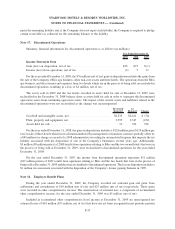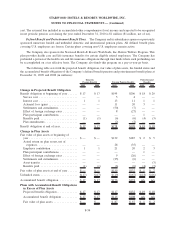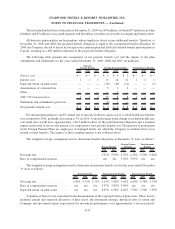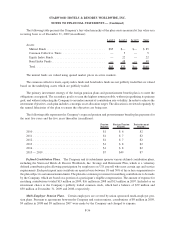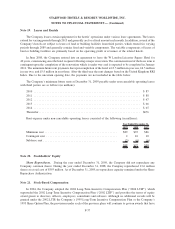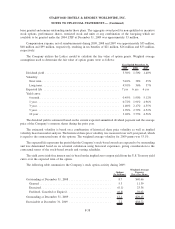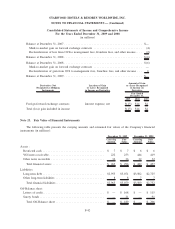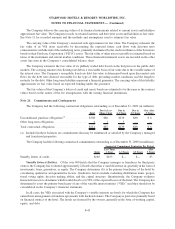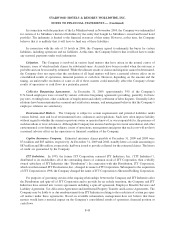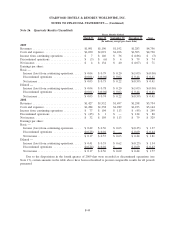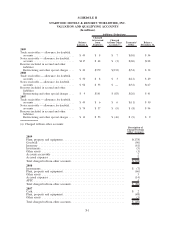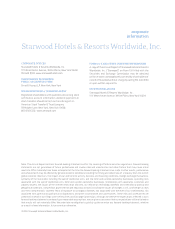Starwood 2009 Annual Report Download - page 166
Download and view the complete annual report
Please find page 166 of the 2009 Starwood annual report below. You can navigate through the pages in the report by either clicking on the pages listed below, or by using the keyword search tool below to find specific information within the annual report.
The Company believes the carrying values of its financial instruments related to current assets and liabilities
approximate fair value. The Company records its retained interests and derivative assets and liabilities at fair value.
See Note 11 for recorded amounts and the methods and assumptions used to estimate fair value.
The carrying value of the Company’s restricted cash approximates its fair value. The Company estimates the
fair value of its VOI notes receivable by discounting the expected future cash flows with discount rates
commensurate with the risk of the underlying notes, primarily determined by the credit worthiness of the borrowers
based on their Fair Isaac Corporation (“FICO”) scores. The fair value of other notes receivable is estimated based on
terms of the instrument and current market conditions. These financial instrument assets are recorded in the other
assets line item in the Company’s consolidated balance sheet.
The Company estimates the fair value of its publicly traded debt based on the bid prices in the public debt
markets. The carrying amount of its floating rate debt is a reasonable basis of fair value due to the variable nature of
the interest rates. The Company’s non-public fixed rate debt fair value is determined based upon discounted cash
flows for the debt rates deemed reasonable for the type of debt, prevailing market conditions and the length to
maturity for the debt. Other long-term liabilities represent a financial guarantee. The carrying value of this liability
approximates its fair value based on expected funding under the guarantee.
The fair values of the Company’s letters of credit and surety bonds are estimated to be the same as the contract
values based on the nature of the fee arrangements with the issuing financial institutions.
Note 24. Commitments and Contingencies
The Company had the following contractual obligations outstanding as of December 31, 2009 (in millions):
Total
Due in Less
Than 1 Year
Due in
1-3 Years
Due in
3-5 Years
Due After
5 Years
Unconditional purchase obligations
(a)
............. $308 $86 $136 $80 $ 6
Other long-term obligations .................... 4 1 3 — —
Total contractual obligations ................... $312 $87 $139 $80 $ 6
(a) Included in these balances are commitments that may be reimbursed or satisfied by the Company’s managed
and franchised properties.
The Company had the following commercial commitments outstanding as of December 31, 2009 (in millions):
Total
Less Than
1 Year 1-3 Years 3-5 Years
After
5 Years
Amount of Commitment Expiration Per Period
Standby letters of credit .......................... $168 $165 $— $— $3
Variable Interest Entities. Of the over 900 hotels that the Company manages or franchises for third party
owners, the Company has evaluated approximately 22 hotels that it has a variable interest in, generally in the form of
investments, loans, guarantees, or equity. The Company determines if it is the primary beneficiary of the hotel by
considering qualitative and quantitative factors. Qualitative factors include evaluating distribution terms, propor-
tional voting rights, decision making ability, and the capital structure. Quantitatively, the Company evaluates
financial forecasts to determine which would absorb over 50% of the expected losses of the hotel. The Company has
determined it is not the primary beneficiary of any of the variable interest entities (“VIEs”) and they should not be
consolidated in the Company’s financial statements.
In all cases, the VIEs associated with the Company’s variable interests are hotels for which the Company has
entered into management or franchise agreements with the hotel owners. The Company is paid a fee primarily based
on financial metrics of the hotel. The hotels are financed by the owners, generally in the form of working capital,
equity, and debt.
F-43
STARWOOD HOTELS & RESORTS WORLDWIDE, INC.
NOTES TO FINANCIAL STATEMENTS — (Continued)


